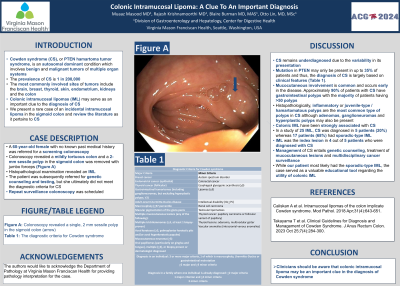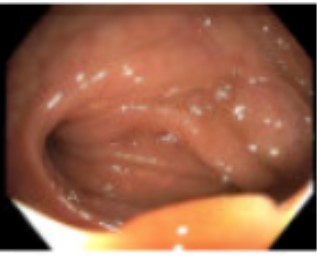Monday Poster Session
Category: Colon
P2046 - Colonic Intramucosal Lipoma: A Clue to an Important Diagnosis
Monday, October 28, 2024
10:30 AM - 4:00 PM ET
Location: Exhibit Hall E

.jpg)
Muaaz Masood, MD
Virginia Mason Franciscan Health
Seattle, WA
Presenting Author(s)
Muaaz Masood, MD, Rajesh Krishnamoorthi, MD, Blaire Burman, MD, MAS, Otto Lin, MD
Virginia Mason Franciscan Health, Seattle, WA
Introduction: Cowden syndrome (CS), or PTEN hamartoma tumor syndrome, is an autosomal dominant condition which involves benign and malignant tumors of multiple organ systems. The prevalence of CS has been reported to be 1 in 200,000. The most commonly involved sites of tumors include the brain, breast, thyroid, skin, endometrium, kidneys and the colon. Colonic intramucosal lipomas (IML) may serve as an important clue to the diagnosis of CS. We present a rare case of an incidental intramucosal lipoma in the sigmoid colon and review the literature as it pertains to CS.
Case Description/Methods: A 60-year-old female with no known past medical history was referred for a screening colonoscopy. Colonoscopy revealed a mildly tortuous colon and a 2-mm sessile polyp in the sigmoid colon was removed with jumbo forceps (Figure A). Histopathological examination revealed an IML. The patient was subsequently referred for genetic counseling and testing. However, she ultimately did not meet the diagnostic criteria for CS. Repeat surveillance colonoscopy was scheduled.
Discussion: CS remains underdiagnosed due to the variability in its presentation. Mutation in PTEN may only be present in up to 35% of patients and thus, the diagnosis of CS is largely based on clinical features (Table 1). Mucocutaneous involvement is common and occurs early in the disease. Approximately 90% of patients with CS have gastrointestinal polyps with the majority of patients having >50 polyps. Histopathologically, inflammatory or juvenile-type / hamartomatous polyps are the most common type of polyps in CS although adenomas, ganglioneuromas and hyperplastic polyps may also be present. Colonic IML have been strongly associated with CS. In a study of 25 IML, CS was diagnosed in 5 patients (20%) whereas 17 patients (68%) had sporadic-type IML. IML was the index lesion in 4 out of 5 patients who were diagnosed with CS. Management of CS entails genetic counseling, treatment of mucocutaneous lesions and multidisciplinary cancer surveillance. While our patient most likely had the sporadic-type IML, the case served as a valuable educational tool regarding the utility of colonic IML. Clinicians should be aware that colonic IML may be an important clue in the diagnosis of CS.
References:
Caliskan A et al. Intramucosal lipomas of the colon implicate Cowden syndrome. Mod Pathol. 2018 Apr;31(4):643-651.
Takayama T et al. Clinical Guidelines for Diagnosis and Management of Cowden Syndrome. J Anus Rectum Colon. 2023 Oct 25;7(4):284-300.

Note: The table for this abstract can be viewed in the ePoster Gallery section of the ACG 2024 ePoster Site or in The American Journal of Gastroenterology's abstract supplement issue, both of which will be available starting October 27, 2024.
Disclosures:
Muaaz Masood, MD, Rajesh Krishnamoorthi, MD, Blaire Burman, MD, MAS, Otto Lin, MD. P2046 - Colonic Intramucosal Lipoma: A Clue to an Important Diagnosis, ACG 2024 Annual Scientific Meeting Abstracts. Philadelphia, PA: American College of Gastroenterology.
Virginia Mason Franciscan Health, Seattle, WA
Introduction: Cowden syndrome (CS), or PTEN hamartoma tumor syndrome, is an autosomal dominant condition which involves benign and malignant tumors of multiple organ systems. The prevalence of CS has been reported to be 1 in 200,000. The most commonly involved sites of tumors include the brain, breast, thyroid, skin, endometrium, kidneys and the colon. Colonic intramucosal lipomas (IML) may serve as an important clue to the diagnosis of CS. We present a rare case of an incidental intramucosal lipoma in the sigmoid colon and review the literature as it pertains to CS.
Case Description/Methods: A 60-year-old female with no known past medical history was referred for a screening colonoscopy. Colonoscopy revealed a mildly tortuous colon and a 2-mm sessile polyp in the sigmoid colon was removed with jumbo forceps (Figure A). Histopathological examination revealed an IML. The patient was subsequently referred for genetic counseling and testing. However, she ultimately did not meet the diagnostic criteria for CS. Repeat surveillance colonoscopy was scheduled.
Discussion: CS remains underdiagnosed due to the variability in its presentation. Mutation in PTEN may only be present in up to 35% of patients and thus, the diagnosis of CS is largely based on clinical features (Table 1). Mucocutaneous involvement is common and occurs early in the disease. Approximately 90% of patients with CS have gastrointestinal polyps with the majority of patients having >50 polyps. Histopathologically, inflammatory or juvenile-type / hamartomatous polyps are the most common type of polyps in CS although adenomas, ganglioneuromas and hyperplastic polyps may also be present. Colonic IML have been strongly associated with CS. In a study of 25 IML, CS was diagnosed in 5 patients (20%) whereas 17 patients (68%) had sporadic-type IML. IML was the index lesion in 4 out of 5 patients who were diagnosed with CS. Management of CS entails genetic counseling, treatment of mucocutaneous lesions and multidisciplinary cancer surveillance. While our patient most likely had the sporadic-type IML, the case served as a valuable educational tool regarding the utility of colonic IML. Clinicians should be aware that colonic IML may be an important clue in the diagnosis of CS.
References:
Caliskan A et al. Intramucosal lipomas of the colon implicate Cowden syndrome. Mod Pathol. 2018 Apr;31(4):643-651.
Takayama T et al. Clinical Guidelines for Diagnosis and Management of Cowden Syndrome. J Anus Rectum Colon. 2023 Oct 25;7(4):284-300.

Figure: Figure A. Colonoscopy revealed a single, 2 mm sessile polyp in the sigmoid colon.
Note: The table for this abstract can be viewed in the ePoster Gallery section of the ACG 2024 ePoster Site or in The American Journal of Gastroenterology's abstract supplement issue, both of which will be available starting October 27, 2024.
Disclosures:
Muaaz Masood indicated no relevant financial relationships.
Rajesh Krishnamoorthi indicated no relevant financial relationships.
Blaire Burman indicated no relevant financial relationships.
Otto Lin indicated no relevant financial relationships.
Muaaz Masood, MD, Rajesh Krishnamoorthi, MD, Blaire Burman, MD, MAS, Otto Lin, MD. P2046 - Colonic Intramucosal Lipoma: A Clue to an Important Diagnosis, ACG 2024 Annual Scientific Meeting Abstracts. Philadelphia, PA: American College of Gastroenterology.
